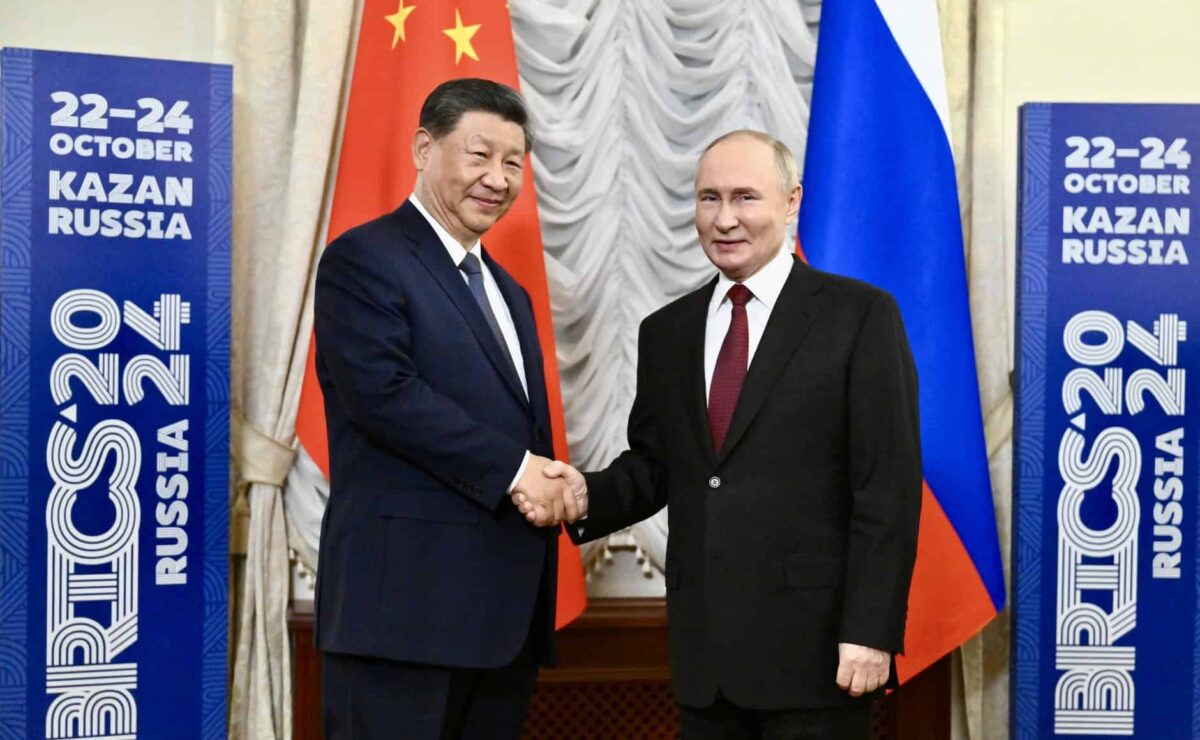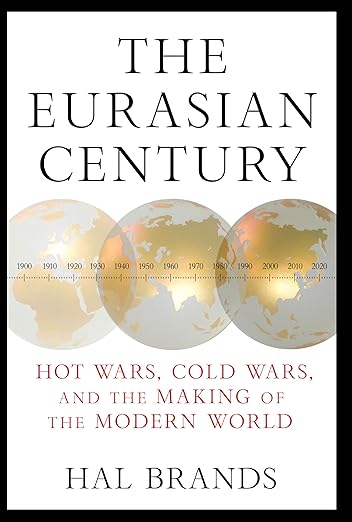
Hal Brands is an American scholar of U.S. foreign policy. He is Professor of Global Affairs at the Center for Global Affairs at Johns Hopkins University, and a scholar at the American Enterprise Institute. He has also served as special assistant to the Secretary of Defense for strategic planning, and as a member of the Secretary of State’s foreign affairs policy board. He is the author of nine books, including Danger Zone: The Coming Conflict With China (2022), American Grand Strategy in the Age of Trump (2018) and What Good is Grand Strategy? (2014).
In a Q&A ungated from our sibling site The Wire China, Brent Crane catches up with Hal Brands about his latest new book, The Eurasian Century: Hot Wars, Cold Wars, and the Making of the Modern World (W. W. Norton, January 2025). Brands discusses why he thinks China is the most formidable player in an emerging “axis of autocracies,” and what Washington should do about it.
How did you come to write this book?
This was a case of working backwards. I’ve been writing about the ways in which Russia, China, Iran and North Korea are threatening the balance of power within their respective regions, all of which happen to be around the periphery of Eurasia. As a historian, I was aware that this isn’t the first time autocratic states or coalitions have tried to establish themselves as the dominant powers within Eurasia. I thought it would be interesting to look at previous periods in which the democratic world faced this challenge, to think about how different intellectuals and geopolitical thinkers had conceived of this sort of problem, and to figure out what it could all tell us about the world we confront today.
I came across Halford Mackinder’s famous lecture, “The Geographical Pivot of History,” back in grad school. The idea that Eurasia is the world’s strategic center, where the greatest challenges to global order originate, where the hottest contests over the future of the international system play out: that idea has been with me for a while. But it was really the combination of seeing how China was intensifying its pressure against Taiwan and elsewhere in the first island chain, plus how Russia and Iran were pushing for advantage in their regions that really got me thinking about whether there was a deeper story to tell here.
The book revolves around the claim that Eurasia is the critical landmass for global security. Why is that?
It’s where most of the earth’s population and most of its economic potential are found, which means that if a single power comes to dominate Eurasia they are very likely to dominate the world. They can use Eurasia to project power across the oceans that touch it. They can use it to coerce their enemies on a global scale. The great fear of the 20th century was that some group of states would succeed in dominating Eurasia and that would make countries everywhere insecure. That’s what we saw aggressive states try in World War I and World War II. It’s what the U.S. and its allies tried to prevent in the Cold War. There is a very similar pattern at work today.
That brings us to the so-called “axis of resistance” or “axis of autocracies.” What is that?
Different people call this thing by different names. Basically what it refers to is the thickening web of strategic ties among the states that are most aggressively challenging the international system. These relationships date back decades in many cases. But they have grown and they have flourished in the context of the wars in Ukraine and, more recently, the Middle East. These wars have created a hothouse geopolitical environment. They have encouraged the Eurasian autocracies — China, Russia, Iran, North Korea — to forge closer ties so that they can join together for purposes of both self-protection and geopolitical predation. And while these relationships don’t look like America’s alliances, they have a bunch of important strategic effects. They encourage disruptive military innovation. They help Russia sustain its war in Ukraine. They reduce the isolation that aggressive states would otherwise face. So they have a variety of effects, all of which are quite disruptive from the perspective of the United States and its allies.

(Russian Presidential Executive Office)
What role does China play in this axis?
China is the most formidable of the Eurasian autocracies. It poses, in my view, the greatest threat to the survival of the U.S.-led world order. That’s true certainly in East Asia, where the Chinese military challenge is most severe. But it’s true on a global scale as well. Look at how China is trying to make itself the international economic and technological heavyweight of the 21st century. At the same time, China plays a key role in strengthening the other Eurasian autocracies. Even though a lot of attention has rightly been paid to the fact that Iran and North Korea have contributed weapons (and, in North Korea’s case, troops) in support of Russia’s war in Ukraine, there’s no way Putin could have sustained the war for so long without his economic relationship with China. China has helped to rebuild Russia’s defense industrial base. It has provided an outlet for Russian goods. It has become increasingly intertwined with Russia economically, financially and technologically. So China is, by itself, the most formidable of the autocracies, and also the one that helps intensify the threats the others pose.
Yet, out of all of these states, China is the one we’re most intertwined with. Trade and peer-to-peer relationships with Chinese companies are still pretty robust. What’s the evidence that China wants to upend the U.S.-led order from which it benefits so much?
Yes, China is the most intertwined with the existing world order and it has the most to lose if that order is disrupted. After all, China is still dependent on the global economy. It’s still dependent on technological inputs from the United States and other Western countries, although it’s trying to reduce that dependence urgently. China has also not challenged the system as violently as Russia or Iran have in the last couple of years.
But if you look at China’s aims, it’s hard to reconcile them with the international system as we know it. That’s true if you look just at China’s territorial claims against its neighbors. The Greater China that Xi Jinping is trying to put together includes Hong Kong and Taiwan but it also includes about 90% of the South China Sea; a chunk of India that’s the size of a small European country; and a bunch of other revanchist aims in the Asian littoral and mainland.
There’s also the fact that China is pretty clearly looking for an exclusive sphere of influence in East Asia — “Asia for Asians,” as Xi Jinping called it about a decade ago. Not necessarily one in which China physically dominates the region, but one in which its preferences have to be obeyed and cannot be challenged. And one in which the U.S. is essentially booted to the sidelines of the region.
On a global scale, China also seeks a very different distribution of power. When Chinese officials or propagandists talk about China’s “great rejuvenation”, they are referring to a situation in which China is once again the most advanced, most respected, most powerful country in the world as, in the Chinese narrative, it was for many, many centuries prior to the onset of the century of humiliation in the 1800s.
That doesn’t mean that China is going to create a Sinocentric international order that looks exactly like the American-led international order. I’m sure it will be different in many respects. But just listening to what Chinese leaders say, it’s harder and harder to deny that China seeks a world in which power balances have changed, and in which China has an increasing ability to write the rules of the road in the 21st century in the way that the U.S. wrote them in the 20th.
China is pretty clearly looking for an exclusive sphere of influence in East Asia — “Asia for Asians,” as Xi Jinping called it.
How does this book relate to your last book, Danger Zone?
Danger Zone was a book about a very urgent particular challenge — that China might behave more aggressively and perhaps even use military force in the western Pacific. That’s because its military power is increasing but its economic power — relative to the U.S. and America’s allies — is peaking and may well decline in the coming years. The Eurasian Century is related to that because China and the prospect of Chinese aggression plays an important role in the story.
But this book is broader and deeper. It’s broader in the sense that there’s a larger game that’s going on across Eurasia in which China is one of a series of revisionist powers that are trying to upset the existing order. It’s deeper in the sense that this new book tries to situate the story of contemporary China against this larger historical backdrop that’s provided by more than a century in which the world has seen repeated challenges to Eurasia’s stability.
Turning to solutions, how should Washington strengthen the liberal order against these revisionist powers, especially at a time when isolationism, or something like it, is on the rise in America?
We have to recognize that there is no stable balance of power in Eurasia without the engagement of the United States. The history of the 20th century showed that only America had the capacity to stabilize the key regions of Eurasia, to protect them against aggression from without and also to tamp down on the conflicts within them that had previously torn those regions apart. Nothing has changed dramatically enough since the 20th century to suggest that Eurasia will be able to keep its own balance if the U.S. drops out.
The second lesson, however, is that the United States can’t do it on its own. America’s alliances are absolutely crucial because they give the U.S. access to the key geopolitical regions of Eurasia, particularly Europe and East Asia. They allow the U.S. to create barriers to revisionist states by creating bonds of cooperation with countries that are exposed to the power that the likes of Russia and China wield. So investing in those alliances is going to be a prerequisite to maintaining a congenial world order and a stable Eurasia in the coming decades.
You mentioned abandoning allies. What do you make of “Asia first”-minded strategists like Elbridge Colby who argue that we need to essentially forget Ukraine and focus on Taiwan?
I think the “Asia first” argument rests on a real insight: China does pose the greatest threat to the contemporary international system. That said, I think it’s not quite as easy as saying, “Okay, China is the biggest threat, so we need to radically scale back our involvement in Europe and the Middle East.” This is something that history speaks to. Franklin Roosevelt never doubted that Nazi Germany posed the greatest threat to humanity during World War II. But he also believed that the U.S. had a significant stake in preventing Japan from dominating the Asia Pacific and was willing to run very high risks of war with Tokyo, even as relations with Nazi Germany were going downhill.
There is a parallel today. China may be the biggest threat the U.S. faces over, say, the next decade. But the place where the international order is being stressed most dramatically right now is Ukraine. In part, that’s because the Russian challenge is so violent. But it’s also because Ukraine has essentially become a global proxy war. It’s not just Ukraine and Russia duking it out. Ukraine is being supported by a community of advanced democracies headed by the United States. Russia is being supported by the other Eurasian autocracies. If Russia prevails there, that’s going to have global ramifications. America’s Asian allies and partners — countries like Japan, South Korea and Taiwan — don’t want to see Ukraine defeated because they worry that would have negative ramifications in this larger test of strength between the democratic and autocratic worlds.
What are you expecting for the incoming Trump administration’s approach to Eurasia? [Ed: this interview was conducted before January 2025.]
The band of uncertainty is so wide because Trump embodies the conflicting impulses that have always been there in American statecraft. On the one hand, Trump wants the United States to be the biggest, baddest, most powerful country in the world. I think he intuitively understands, even though he wouldn’t necessarily phrase it in these terms, that the U.S. doesn’t want to live in a world where the rules are set by someone else.
Hal Brands talks at the Modern War Institute on “American Grand Strategy in an Age of Upheaval,” October 2018. (Modern War Institute)
On the other hand, he also questions why the U.S. has such a heavy stake in the security of small, sometimes obscure places like the Baltic states or Ukraine or Taiwan, which are thousands of miles away from the United States. Trump, like a lot of people, wants to have all good things at once. He wants to have a world order that’s structured by the U.S. but without a lot of the commitments and obligations that have long gone into the structuring of that order. So it’s hard to say, at this stage, which part of this worldview will win out.
Each of these three global strategists whose thinking grounds the book — Halford Mackinder, Nicholas Spykman, Alfred Thayer Mahan — all also worked in government. Is that something you would do again?
I spent a little bit of time in government about a decade ago, at the tail end of the Obama years. I was an advisor to Ash Carter when he was the Secretary of Defense. It was a great opportunity to learn and to try to do a little bit of good on behalf of my country. I enjoyed it a lot. And I’ve served on various advisory boards and commissions over the years. But I’m not jonesing for another opportunity to do it on a full-time basis. I try to make my contributions on the intellectual plane and be as helpful to government as I can. That’s the role I’m most comfortable in.
Do you get the sense that Washington policymakers think of Eurasia as a single strategic body in the way that you advocate for in the book?
There was a time when American strategists in and out of government were obsessed with Eurasia. During World War II and the first decade of the Cold War, this idea that you really had to avoid expansionist powers dominating Eurasia was at the forefront of U.S. strategic thinking.
Today, the fact that people think less about Eurasia as a geographic entity reflects the fact that the U.S. was in such a favorable position for a quarter century after the Cold War. It seemed unthinkable that the balance of power could shift so dramatically not just in one region, but in a bunch of regions across the world’s central land mass. That prospect has returned today. There is a dawning realization that the security crises in Europe, East Asia and the Middle East are linked together in more dangerous and more profound ways. American strategists won’t have any choice but to develop a greater understanding of Eurasia’s strategic importance because we’re moving into another era in which a Eurasian coalition of autocracies is pushing to upset the international system.
So we need more grand strategists in government?
Not everyone in government needs to be a grand strategist. But it is useful to have such people around, if only because they can help put a different frame around the issues that policy makers are wrestling with on a day to day basis. If that’s the contribution that a book like this can make, I’d be very happy with that. ∎

Brent Crane is a journalist based in San Diego. His work has been featured in The New Yorker, The New York Times, The Economist and elsewhere. @bcamcrane


